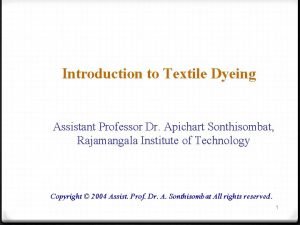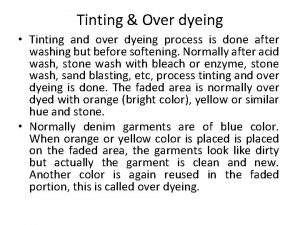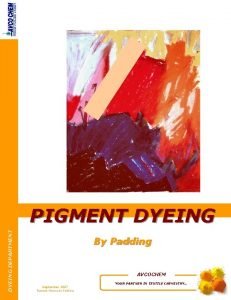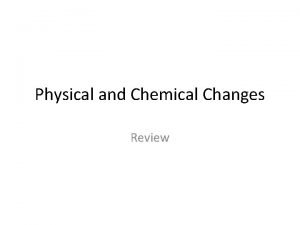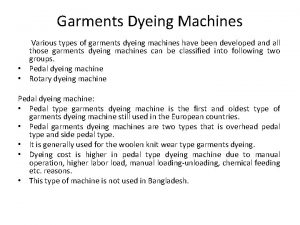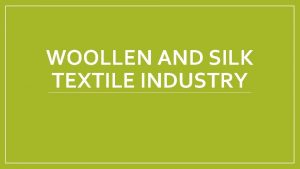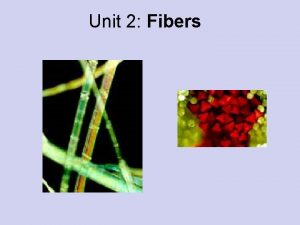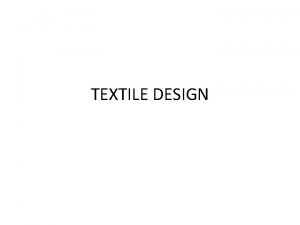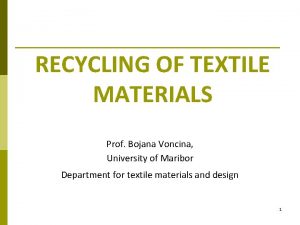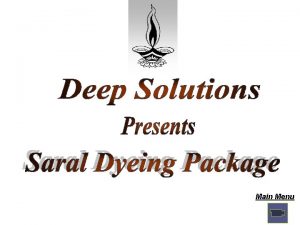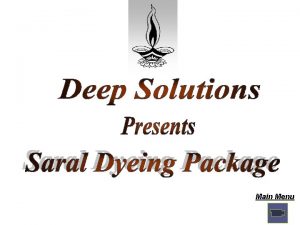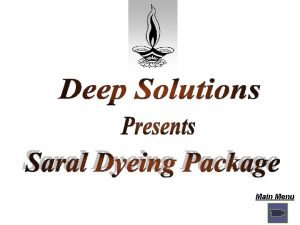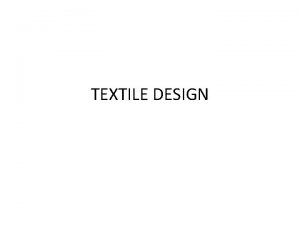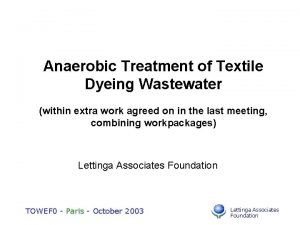Introduction to Textile Dyeing Assistant Professor Dr Apichart










- Slides: 10

Introduction to Textile Dyeing Assistant Professor Dr. Apichart Sonthisombat, Rajamangala Institute of Technology Copyright © 2004 Assist. Prof. Dr. A. Sonthisombat All rights reserved. 1

Basic Textile Terms and Definitions Dyestuff is organic or inorganic substances which can absorb light and reflect some lights to show color. Actually, the dyestuff is water soluble substances. Pigment is a substance that can absorb light and reflect some lights to show color but it is water insoluble substances. Normally it is used for printing (with the presence of binder) or mass-coloration of the synthetic fibers. 2

Dyeing Processes can be applied in many stages such as. 1 Mass-coloration of the molten fibers This method is for dyeing the molten fibers or plastic chips or textile polymers with pigment dyes. After that, the molten or polymers will extrude from a spinneret to form fibers. Normally, the synthetic fibers are added with white pigment in order to give a hiding power (non-see through fabrics. ( Advantage: give excellent fastness 3 Disadvantage: very difficult to clean

. 2 Fiber Dyeing is the method of dyeing fibers before blending with other colors to give fancy yarns or fabrics. Note: This is used for special purposes only. 3. Yarn Dyeing is the method of dyeing yarns in forms of hanks or packages dyeing. This will give Scottish’s style fabrics, carpet with many colors and styles. Note: This is used in hand loom weaving in the Northern and North-eastern parts of Thailand. 4

. 4 Fabric Dyeing is the method after weaving, knitting, or non-woven to make fabrics. This is very popular method of dyeing as the dyed fabrics will be processed further to garment industries very easily. Dyeing forms of the fabric dyeing can be used in 2 ways: . 1 Open width form using the fabrics to spread without any creases and dye them. . 2 Rope form using the fabrics with the form like a rope (many creases and look like “a rope(” 5

Some people classify into: . 1 Exhaustion Process This method is using lot of water as shown in “Liquor Ratio (ratio between water and goods)” This should immerge the goods into dye solution for a long time in order to let the dye penetrate into the goods. This will lead to produce more waste water than the continuous process. Advantage: inexpensive, no need to train the worker to look after and run them properly. Disadvantage: lots of water needed, very 6 slow process (60 -120 min/batch(.

. 2 Continuous Process This method is designed by putting different machinery into a sequence so that it can produce the dyed fabric in one pass. Advantage: very fast process (10 -100 m/min), small amount of water in the process. Disadvantage: very expensive, need to train the worker to look after and run them properly. 7

. 6 Garment Dyeing This method is the last process of the dyeing of goods. However, the penetration of the dye solution may not be completely passed to the fibers such as between the seams, buttons, zippers etc. Normally, it is used for lingerie, socks, sweater dyeing etc. 8

Name of Dyestuffs Acid Basic Direct Disperse Reactive Vat Sulphur Fibers that can be dyed Silk, wool, polyamide , leather Acrylic Cellulosic, viscose Acetate, triacetate, polyamide, polyester, acrylic Cellulosic, viscose, protein Cellulosic 9

Factors that give some choices of the dyestuffs. 1 Cheap. 2 Non-toxic. 3 Compatible to other dyes and chemicals. 4 High color strength. 5 Better brightness. 6 Better fastness. 7 Good levelness on the materials 10
 Printing and dyeing assistant
Printing and dyeing assistant Promotion from associate professor to professor
Promotion from associate professor to professor Cuhk assistant professor salary
Cuhk assistant professor salary Over dyeing process
Over dyeing process Avcochem
Avcochem Is perfume evaporating a chemical change
Is perfume evaporating a chemical change Stainless steel clothes dyeing machine
Stainless steel clothes dyeing machine Distribution of cotton woollen and silk industries map
Distribution of cotton woollen and silk industries map The smallest unit of a textile is called a fiber
The smallest unit of a textile is called a fiber What does textile mean
What does textile mean Depolimerisation
Depolimerisation
